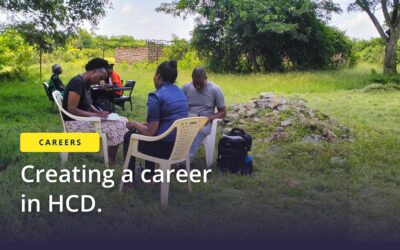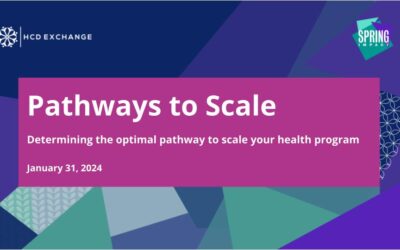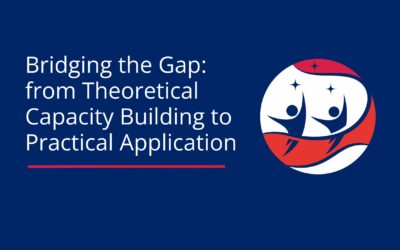In recent years, integrating Human-Centered Design (HCD) principles into public health initiatives has unveiled a paradigm shift in how we approach service delivery to program participants. Introducing experimentation, prototyping, and the concept of “failing fast” challenges traditional methods and offers a promising pathway for innovation and progress. This shift requires a deliberate mindset change and embracing failures as pivotal learning moments, rather than setbacks.
The HCDExchange held a Learning Circle in collaboration with the USAID Advancing Nutrition activity team at JSI to explore the application of the failing fast approach in HCD for implementation research and solution design. This exploratory discussion brought together diverse voices from public health-related projects to share reflections from their own experiences with pivoting and making project adaptations. The insights gathered shed light on fundamental aspects crucial for adopting the mindsets within a project that enable failing, learning, and adapting solutions to ensure the greatest outcomes for program participants.
A Learning Circle is a format that brings together experts in a field to discuss a common topic of interest and learn through open, exploratory dialogue. Participants are invited to share their own experiences and perspectives to learn and exchange with their peers. Key findings from the discussion are synthesized and documented to contribute to field-wide institutional and programmatic learning.
Adopting the “Failing Fast” Mindset
Pivots are not necessarily monumental changes; they are meaningful adjustments that are based on continuous feedback and grounded in contributors’ realities. The HCD approach is flexible to the evolving needs and contexts of the program participants through dynamic, iterative processes. A team dynamic that cultivates a mindset where failures are seen as learning opportunities, not setbacks, is the linchpin for success. HCD practitioners and organizations should be encouraged to leverage failures as stepping stones toward progress and innovation, rather than obstacles to be avoided.
Failing fast isn’t about these big, huge pivots, or that we’ve really failed. But about these kinds of small adaptations that are equally as important to making something successful
Evidence-based approaches may not fit the social-cultural setup of the people they serve. Implementers in the Global South understand that there may be service delivery models guided by evidence generated from other Global South countries. However, these models do not always fit the context, norms or attitudes of the particular communities they serve. As such, implementers need leeway within their programming to adapt the service delivery models based on a co-creation approach with program participants and key stakeholders to ensure the desired results are achieved.
We realized immediately that our ideas, in as much as [they were] supported by evidence, really did not meet the needs and the desires of the people that we were working with, especially the health providers and the women
Engaging Stakeholders in the Process
To design functional solutions that are locally contextualized and resonate with end users, it is crucial to understand user experiences, needs, and challenges. HCD practitioners can achieve this through “ground truthing” or validating ideas and prototypes with participants in real-time, enabling agile adaptation through the design process.
Doing more of listening than talking, I think, is one way to gather the most feedback in the shortest period of time, and this is the biggest enabler when it comes to failing fast and pivoting quickly. [HCD has] that stage whereby you are trying to sensitize the communities on [the data] you have gathered from [them] and it’s like you are validating with them to say, ‘these are the challenges, and these are the possible solutions. Should we really go this way?’ So really trying to confirm with them
Recognize and mitigate power asymmetries to ensure equitable participation and valuable input from all user groups throughout the HCD process. When an intervention has different kinds of actors and users, it is important to identify the power asymmetries early on so that the feedback is gathered in a space where all users feel comfortable and have similar levels of power in a room to speak about an issue. For example, in feedback sessions, it may be necessary to separate program participants from implementers, as they may not be comfortable sharing openly about challenges faced or giving critical feedback in front of the project staff.
If there are hierarchies and power dynamics, sometimes you end up losing high-quality data because some people might not feel comfortable. In as much as people can even write on post-it notes, we found that some participants were not comfortable. They just felt like they could not express themselves freely in front of someone who is in charge of their health.
Agile Decision-Making
It is important to consider who to engage and when throughout the project lifecycle to enable agile decision-making and pivots. The HCD process is fundamentally consultative; capturing and considering many perspectives for different decisions. Although not explicitly referenced by learning circle participants, many HCD practitioners find a DARCI (Decision-Maker, Accountable, Responsible, Consulted, and Informed) framework useful for outlining who to engage and when in decision-making. Equally important is the documentation of these decisions as a reference point for the future.
When a decision is made, we should be transparent about who is making that decision, why, and what are the factors and reasons, and points that kind of went into making that decision
Project teams make decisions on the solution by accounting for variations in input from designers, program participants, and researchers. Implementers can adopt criteria and tools that help to prioritize what is desired by the users against what is feasible, and what will be sustainable for the users to carry on post-implementation period, and donors of such programs should consider resource requirements for the uptake of HCD products.
[Be] intentional about what those parameters are for making decisions and taking into account, what’s sustainable and what’s feasible as well as what’s likable and usable.
The Power in the Pivot
When practicing HCD, failure is not viewed as a setback but an opportunity to embrace learning and take action on improvement through an iterative journey. HCD involves an open and empathetic mindset that, when attained, can allow practitioners and project teams to engage deeply with partners and program participants. This meaningful engagement is essential for creating solutions that are user-centric, contextually relevant, and sustainable. In HCD, each ‘failure’ is a step closer to success.
This learning circle highlighted a need for examples and practical guidance on managing power dynamics within HCD processes. Should you have any resources to share on this or would like to collaborate in the development of a guide, kindly email joel@hcdxtesting.wpengine.com. Read the subsequent learning circle thought piece on “Bridging the Gap – From Theoretical Capacity Building to Practical Application.”




